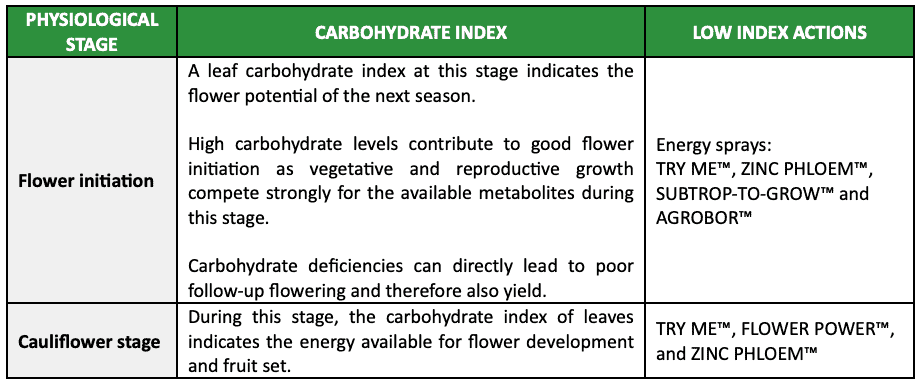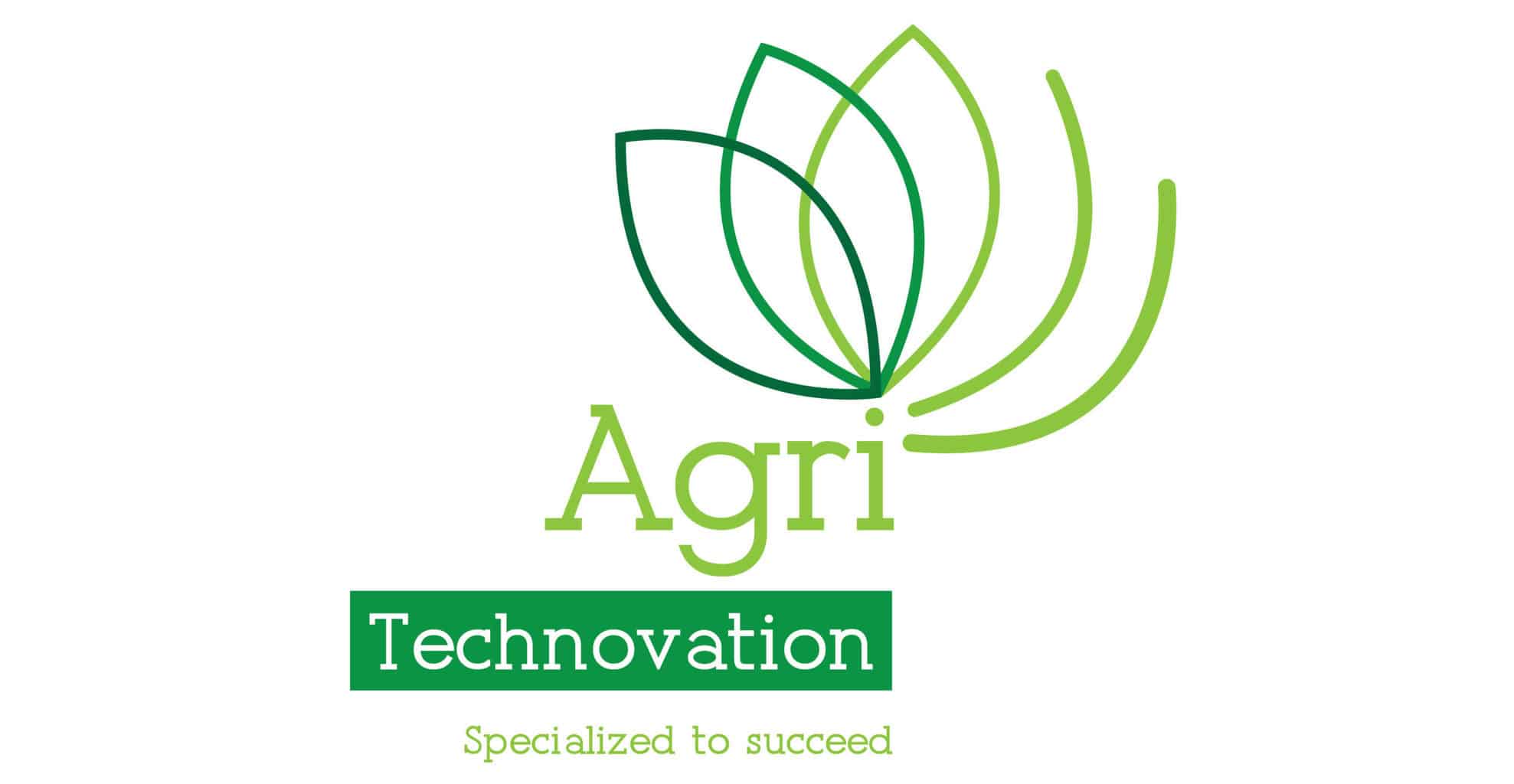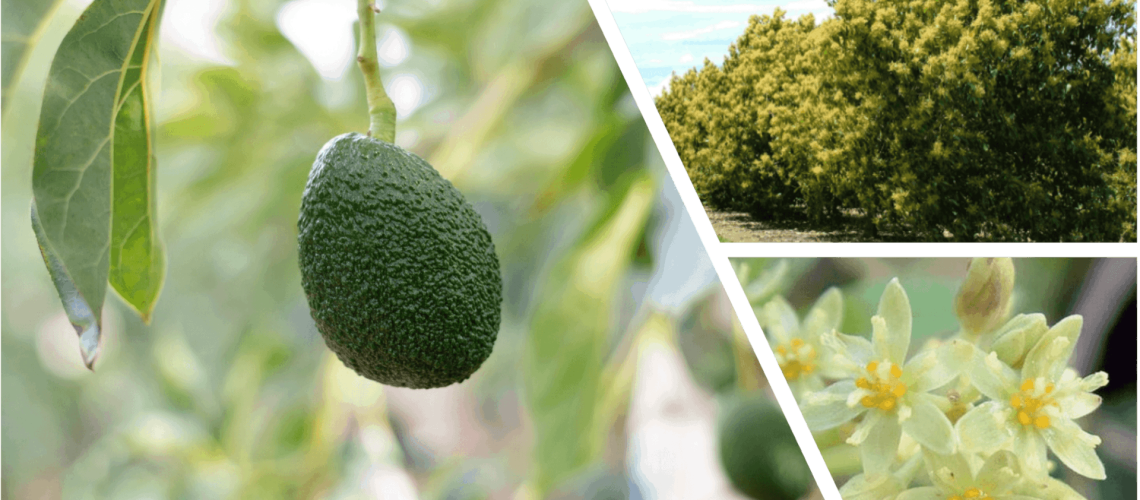Carbohydrates and flower development in avocados
Dr Elmi Lötze (Head of ITEST™CARBOHYDRATES and ITEST™LEAF) and Wilmé Brown (Plant Physiologist)
Flower development requires energy
Avocado trees flower in abundance, though only a small percentage of these flowers set and develop into mature fruit. This process is influenced by carbohydrates and plant hormones.
Carbohydrates (sugar and starch) serve as the energy source of the plant. Sugars, produced by photosynthesis in the leaves, are either utilised by the leaf or translocated to other developing organs. Sugar can also be obtained through starch conversion during periods of poor assimilation or high sink strength. If carbohydrate deficiencies occur during flower development, it could result in a reduction in flower intensity, quality as well as the potential yield. It is therefore important to measure the tree’s energy status (according to the carbohydrate levels) and respond in time before the energy-intensive period of flowering commences.
Successful fruit set starts even before the floret opens and pollination by an insect or wind could take place. The process starts during induction, when a bud is hormonally stimulated to develop reproductively or vegetatively. If the carbohydrate:nitrogen (C/N) ratio is high during this time, flower bud induction is stimulated (Tromp, 2000). In this way, therefore, plant nutrition influences the determination of reproductive induction. Induction is not visually detectable.
In pears, induction occurs from full bloom and lasts for several weeks (Bubán and Faust, 1982), as opposed to initiation which follows thereafter, approximately 60 days after full bloom or at shoot growth cessation, and which can be detected using a scanning electron microscope (Pratt, 1988; Westwood, 1978).

Figure 1: Development of individual avocado flowers (A–G) and pistil (H-K) (California Avocado Society 1951 Yearbook 36:159–163)
Flower bud development
Initiation does not occur on a specific date, but over a period of weeks and varies, depending on the bearing position. Although initiation and bud development can be stimulated by nitrogen fertilisation, it must be applied during late summer of the previous season (Williams, 1965).
Late summer nitrogen applications can, together with a simultaneous increase in hormone translocation from the roots, further contribute to good flower quality (Verheij, 1996). Nutrition therefore also plays a significant role in supporting initiation and differentiation. Furthermore, Bower et al. (1990) confirmed the important role of white root development (production of cytokinins by the white roots) for bud break and sustained production in avocados.
Just like environmental conditions, flower quality likewise contributes significantly to successful fruit set. According to Thorpe et al. (2019), starch levels are low in florets of an on-year avocado tree and high in those of an off-year tree. Low starch levels in flowers lead to a weaker set the following year (Alcaraz and Hormaza, 2009).
Thus, it is important to make provision for sufficient energy for the developing florets in the off-year. Optimal photosynthesis and transportation of the carbohydrates to the flowers of on-year trees should be prioritised, to manage fruit set in the off-year.
Leaf analyses can indicate whether the mineral elements are sufficient for optimal photosynthesis, as well as whether the nutritional element levels are sufficient to ensure the transport of sugar to the flowers. Starch accumulation depends on sugar synthesis in the leaves, as well as the number of sinks at a given time. The abundant flowering of avocados (high energy consumption) places an additional burden on the synthesis and distribution of sugar during flowering. Sugar analyses of avocado florets indicated that one open avocado flower contains 55 mg of sugar (AT). Thus, one avocado tree will need up to 55 kg of sugar for flower development during the flowering period. Additional energy sprays during this period of intensive carbohydrate consumption may partially address this, along with irrigation and crop regulation.

Figure 2: The order of sink strength of the organs of an avocado tree.
Normal flower development also requires sufficient mineral elements, in balance (Westwood, 1978). Here, especially boron (B) plays a particularly important role. In avocados, boron forms a complex with sugar (perseitol) for transport in the phloem, from the leaves to the flowers and fruits (Thorpe et al., 2011). Although the developing flower is a strong sink for carbohydrates and minerals, the fruit on the tree is the strongest sink (Figure 2). Thus, when both the flowers and fruit are on the tree at the same time, such as during flowering, carbohydrates will preferentially be translocated to the fruit and, to a lesser extent, the flowers. This also influences the boron requirement of the sinks, which is now required in higher concentrations. Due to the stronger competing sink action of the fruit, it is of great importance to apply additional boron before flowering, to meet the fruit’s need and thus reduce the direct competition with the flowers. This will ensure that adequate boron is available in the leaves for development and pollination of the flowers.
Management actions to address a low carbohydrate index
With the necessary nutritional inputs, the tree’s photosynthetic capacity can be increased to meet the carbohydrate requirement for the developmental period of the flower bud until flowering. If low carbohydrate levels occur due to a high fruit load or adverse climatic conditions, flower development, the number of flower buds, flower quality and future fruit set may suffer as a result.
Conclusion
It is therefore important to measure the trees’ carbohydrate levels timeously to make the necessary adjustments. Measuring and analyses of carbohydrates are possible with the ITEST™CARBOHYDRATES service provided by Agri Technovation. These carbohydrate analyses are performed at the Agri Technovation laboratory in Wellington, South Africa and enable the producer to take the necessary actions, in time, to ensure that their avocado trees have sufficient energy levels for successful flower development.
References:
- Bower et al., 1990. Interaction of plant growth regulators and carbohydrate in flowering and fruit set. Acta Hort. 275:425-434.
- Bubán en Faust, 1982. Flower bud induction in apple trees: internal control and differentiation. Hortic. Rev. 4: 174–203.
- Alcaraz en Hormaza, 2009. Avocado Pollination and Fruit Set – A Perspective from Spain. California Avocado Society 2009 Yearbook 92:113-135
- Pratt, 1988. Apple flower and fruit: Morphology and anatomy. Rev. 10: 273- 308.
- Thorpe et al., 2011. Is boron transport to avocado flowers regulated by carbohydrate supply? Proceedings VII World Avocado Congress 2011.
- Thorpe et al., 2019. Alternate bearing in Hass avocado: Possible role of carbohydrates and boron. Presentation at 4th Australian and New Zealand Avocado Growers Conference in Cairns.
- Tromp, 2000. Flower bud formation in pome fruits as affected by fruit thinning.Plant Growth Regulation. 31: 27-34
- Verheij, 1996. Morphological aspects of the early phases of flower bud formation of apple. Thesis, Agricultural University Wageningen, pp. 147.
- Westwood, 1978. In: ‘Temperate-zone pomology.’ San Francisco, W. H. Freeman and Company
- Williams, 1965. The effect of summer nitrogen applications on the quality of apple blossom. Hort. Sci. 40, 31-41.

